 |
 |
![]()
Whalley Douglas Charles NX 43037 Medical Orderly - |
|
Douglas Whalley was born in Stains, England on 17 November 1921. His family migrated to Australian when he was just one year old and it is recorded that he always regarded Australia as his “homeland”. He had his primary education at Bay Street School, Botany and high school education at Gardners Road, Mascot.
After leaving school he took an apprenticeship in boot-making at Alexandria and at the age of 17 joined the Militia in the Light Horse.
He was an accomplished soccer player and initially played for the Mascot Congregational Church team where he had a common interest with the girl who was to become his wife Beryl.
On 18 August 1941, at age 20, Doug joined the Australian Imperial Force (AIF). He had to tell a mistruth to enlist, as boot-making was a protected industry. He was allocated to the13 Australian General Hospital and rose to the rank of Lance Corporal. He was a part of the 8th Australian Division when it was captured in Singapore, with capitulation taking place on 15 February 1942.
It seems he was employed as a Medical Orderly. He would probably have assisted in the care of the sick and wounded at the Roberts Barracks Hospital in 1942 and part of 1943. Then in April 1943 he was sent to Thailand a part of a group known as “F” Force. This party comprised 7,000 POWs, about 3,400 British and 3,600 Australians.
They travelled to Thailand in steel goods wagons, with about 30 men crammed into each carriage. The trip took 5 days – 4 nights- with spasmodic stops for food and toilet requirements. On arrival they were then forced to march nearly 300 kms in a northerly direction towards the border with Burma. They marched at night because of the excessive heat. The death rate of this Force was the highest of all groups with an overall death rate of 43%.
Around September 1943, following approaches by Major Bruce Hunt (an Australian Medical Officer and others around 2,000 sick from “F” Force were moved to a so-called Hospital Camp at Tanbaya in Burma. This was a quite unsuitable place for the hospital for this force and in the space of around 12 weeks 671 of them died.
With the above background it is now appropriate that you read tributes to the work of Douglas Whalley in caring for his fellow sick and wounded. What follows are copies of the actual recommendations written by Medical Officers and others in places of responsibility.
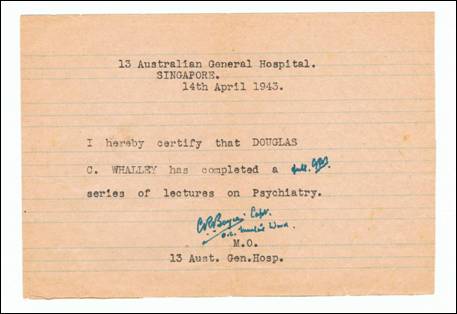
From Capt. C.R. Boyce – Medical Officer 13 AGH who spent a significant amount of time as a POW in Japan
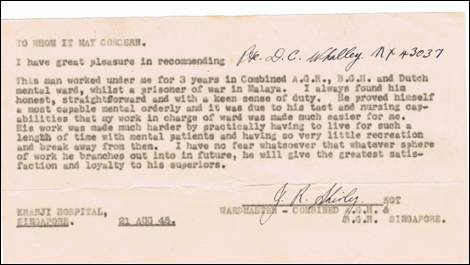
TO WHOM IT MAY CONCERN I have pleasure in recommending Pte D.C. Whalley.NX43037. This man worked under me for 3 years in combined A.G.H and B.G.H. and Dutch mental ward, whilst a prisoner of war in Malaya. I always found him honest, straightforward and with a keen sense of duty. He proved himself a most capable mental orderly and it was due to his tact and nursing capabilities that my work in charge of ward was made much easier for me. His work was made much harder by practically having to live for such a length of time with mental patients and having so very little recreation and a break away from them. I have no fear whatsoever that whatever sphere of work he branches out to in the future, he will give the greatest satisfaction and loyalty to his superiors.
Kranji Hospital; Singapore, 21 Aug 45 S.R.Shirley Sgt Wardmaster, Combined AGH & BGH Singapore
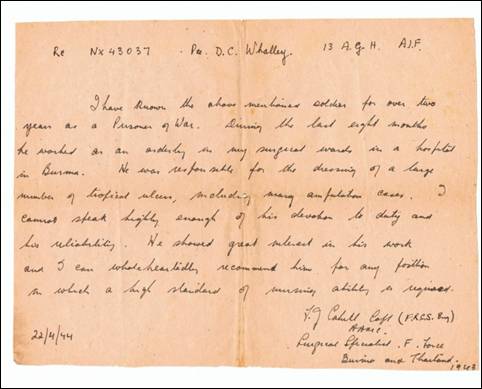
RE NX43037 Pte D.C.Whalley 13 AGH AIF I have known the above mentioned soldier for over two years as an orderly in my surgical ward in a hospital in Burma. He was responsible for the dressing of a large number of tropical ulcers, including many amputation cases. I can not speak highly enough of his devotion to duty and his reliability. He showed great interest and I can wholeheartedly recommend him for any position in which a high standard of nursing ability is required.
22/4/44 F.J.Cahill Capt (FRCS Eng) AAMC Surgical Specialist “F” Force Burma and Thailand.
Note The Burma Hospital was the notorious Tanbaya (50 kilo camp). There were 671 deaths over 3 months.
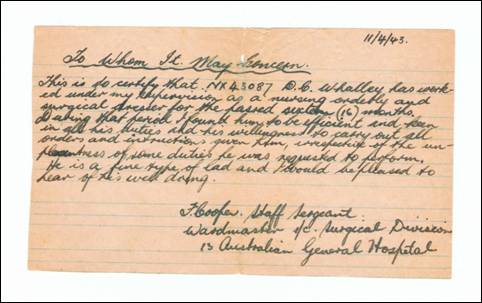
To Whom It May Concern 11/4/43
This is to certify that NX43087 D.C. Whalley has worked under my supervision as a nursing orderly and surgical dresser for the passed sixteen (16) months. During that period I found him to be efficient and keen in all his duties and his willingness to carry out all orders and instructions given him, irrespective of the unpleasantness of some duties he was requested to perform. He is a fine type of lad and I would be pleased to hear of his well doing.
…..F. Cooper Staff Sergeant: Wardmaster i/c Surgical Division 13 Australian General Hospital.
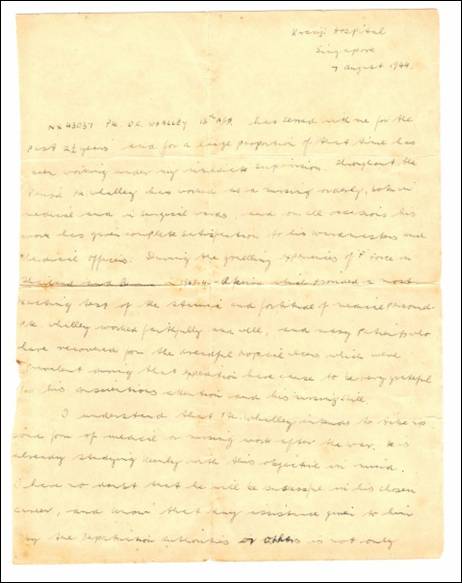
Kranji Hospital Singapore 7 August 1944
NX43037 Pte D.C. Whalley 13th AGH has served with me for the past 2-1/2 years and for a large proportion of that time has been working under my immediate supervision. Throughout the period Pte Whalley has worked as a nursing orderly, both in medical and in surgical wards and on all occasions his work has given complete satisfaction to his wardmasters and Medical officers. During the gruelling experiences of ‘F’ Force in Thailand and Burma in 1943-44 – a period which provided a most exacting test of the stamina and fortitude of medical personnel, Pte Whalley worked faithfully and well, and many patients who have recovered from the dreadful tropical ulcers which were prevalent during that expedition have cause to be very grateful for his conscientious attention and his nursing skill.
I understand that Pte Whalley intends to take up some form of medical or nursing work after the war. He is already studying keenly with this objective in mind. I have no doubt that he will be successful in his chosen career, and know that any assistance given to him by the repatriation authorities or others is not only
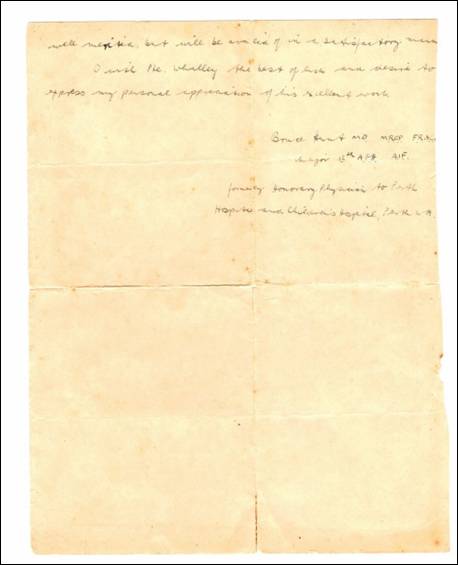
well merited but will be availed of in a satisfactory manner.
I wish Pte Whalley the best of luck and desire to express my personal appreciation of his excellent work.
….Bruce Hunt MD MRCP FRACP Major 13th AGH AIF formerly Honorary Physician to Perth Hospital and Children’s Hospital, Perth WA.

Re NX43037 Pte Whalley D.C. 13 AGH
Between December 1943 & April 1944 this soldier was employed as a nursing orderly & surgical dresser in my ward at the Kanchanburi prisoner of war camp hospital Thailand. His duties were the general nursing care of approximately 40 patients & the performance of many surgical dressings some of these being extensive.
I found Pte Whalley to be a thoroughly competent & keen nursing orderly. He is gentle & considerate with his patients: he has a sound knowledge of antisepsis & asepsis & his technique in carrying out surgical dressings is clean, neat & quick. The patients under his care were always very well cared for.
The characteristic however which impressed me most is his keen interest in & lively enthusiasm for medical work. During the four months of my association with him he was always an earnest seeker after knowledge asking many intelligent questions & reading avidly every medical text book available to him.
His ambition is to become a mental nurse a position for which his many good qualities admirably suit him.
Kanchanaburi Thailand 8:4:’44. John L Taylor Captain AAMC
The following air-letter received in Australia in 1990 from a former British POW Stan Prior pays tribute to the care by Doug Whalley at the dreadful Tanbaya Hospital Camp in 1943.

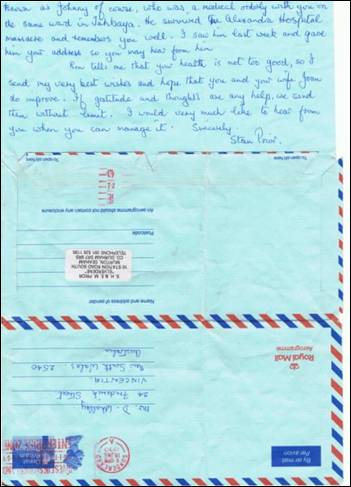
19.6.90 Dear Doug,
After all these years how pleased I am to be able to write and say “Thank You” for all that you did for me in 1943 during our stay in Tanbaya “Hospital”. Words seem to be so inadequate, but my gratitude is still there and I like to think that I am really speaking for all of us who survived those unpleasant months. I was sent your address by Ron Hassett a couple of weeks ago and I understand that he had mentioned me to you. To his day I remember the amazing coincidence when you first asked me if I knew him. I remember telling you that there are nearly half a million people in the Newcastle area, but many months later when I was on the maintenance staff at Kranji Hospital, a tiny note was smuggled to me by an Aussie from Changi and Ron gave me his name and address as 75 Jefferson Street, Newcastle. Imagine my amazement, because my address was 77 Jefferson Street. The flat above! I found out much later, when I got home, that Ron had gone out to Australia a few months before we had moved into 77. So I did not know his family. As a boy of 20 I spent very little time at home, but when I returned, a pretty little girl in ATS uniform was there to greet me with “Hell, I’m Joyce. Did you meet my brother Ronnie?” What can one say to that!
I tried to get a note back to Ron, but it never reached him. It was difficult as you know, and to this day we still have to meet. Each time he has been to England I have been in hospital for one thing or another.
Fortunately I am in quite good health. My leg with the ulcer is still attached, I refused to let Major Bruce Hunt do what he wanted after many words one Sunday morning.
Recently I made contact with a chap, George Johnson known as Johnny of course, who was a medical orderly with you on the same ward in Tanbaya. He survived the Alexandra Hospital massacre and remembers you well. I saw him last week and gave him your address so you may hear from him.
Ron tells me that your health is not too good, so I send my very best wishes and hope that you and your wife Joan do improve. If gratitude and thoughts are any help, we send them without limit. I would very much like to hear from you when you can manage it. Sincerely Stan Prior.
The above tributes can, with a little difficulty, be read. I think they have more impact in this form although for clarity they have been retyped.
Doug returned to Australian on 10 October 1945 and was discharged from the AIF on 22 November 1945. It seems that he considered his educational background to be insufficient to pursue a career as, say, a doctor of medicine. This potential is alluded to in the tributes by some of the above papers.
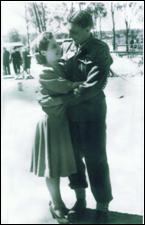
 He and Beryl married on 23 February 1946. They had no children.
He and Beryl married on 23 February 1946. They had no children.
The picture on the left is of Doug and Beryl after his liberation and return to Australia and is dated October 1945.
Also displayed is an arrangement of personal artefacts depicting his military career.
Post War he worked for Austral Bronze for 26 years, with 11 years as a foreman. But for part of his Post War life he resumed a military career in the Citizens Military Force where he attained the rank of Regimental Sergeant Major.
Doug Whalley passed away in September 2007.
Article composed by Lt Col (retd) Peter Winstanley OAM RFD JP with the assistant of Beryl Whalley and Geoffrey Dunn who delivered the Eulogy at Doug’s funeral. Former, and fellow POW, Max Venables put Beryl Whalley and the writer in touch.
|
|